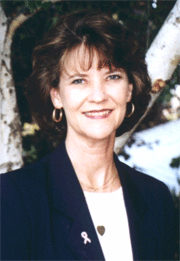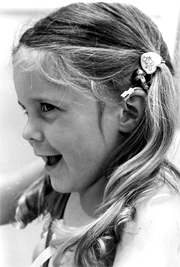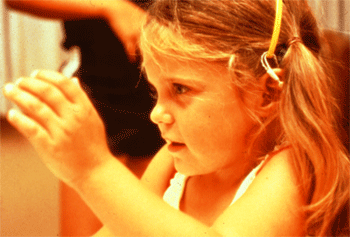Interview with Margaret Winter, M.S., Clinical Coordinator of the Children's Auditory Research and Evaluation, (CARE) Center, House Ear Institute, Los Angeles, California
Topic: The CARE Center at the House Ear Institute
 Beck: Hi Margaret. Thanks for your time today. Please tell me a little about your professional history?
Beck: Hi Margaret. Thanks for your time today. Please tell me a little about your professional history?Winter: I graduated with my master's from the University of Redlands in 1977 and I've worked as a clinical audiologist in Los Angeles since that time. I'm the Clinical Coordinator of the CARE Center at the House Ear Institute, and I've been here for eleven years.
Beck: Margaret, I know the CARE Center is a multidisciplinary center for children. Would you please tell me a little about that?
Winter: The clinical staff in the CARE Center and the scientific staff in the Institute's CARE Research Department work together to provide children who have hearing loss with a complete program of intervention and rehabilitation to optimize their communication skills. CARE Center clinical services include diagnostic audiology (including ABR/OAEs/ASSR and behavioral testing of children of all ages), hearing aid fitting and dispensing, and evaluations and therapy for children with hearing loss. We partner with the surgeons at the House Clinic to employ a team approach in providing cochlear implant services to children. Our professional staff consists of seven audiologists, a speech/language pathologist, an educational liaison, and two consulting psychologists for our cochlear implant team. As a feature of our team approach, we communicate regularly with educators, therapists, social workers and other service providers of the children we see here.
Beck: And I suppose one of the most important things you do is serve as a resource for parents and teachers?
Winter: Absolutely. In fact our staff educational liaison contacts parents and school personnel prior to a cochlear implant pre-evaluation to get their input and also to ensure that it is not a surprise to the school when one of their children receives an implant. After implantation, our liaison goes to the local schools to be sure the teachers and the administrators know how the implant works, how to make sure it's working, and how to maximally provide for that child in an efficient and meaningful way, while setting appropriate educational expectations. So we make sure the classroom teacher, the speech language pathologist and the school audiologist work together toward the same goals, with appropriate knowledge about cochlear implants. The last thing we want is a teacher surprised by a cochlear implant!

Tracy Husted, the first pre-school-aged child to receive
a cochlear implant in the U.S. (1981, HEI)
Beck: Margaret, this may seem a little silly...but do you offer the same programs for children with hearing aids?
Winter: We really don't - and it's not a silly question at all. The children wearing hearing aids face many of the same issues as children with cochlear implants. Nonetheless, school personnel are more accustomed to hearing aids, they know what they are, they've usually seen them before, and so although educationally based aural rehabilitation is very important, we generally depend on the school districts' educational audiologists and other professionals to address hearing aid amplification in the schools. However, if a particular school needed an orientation on how to deal with hearing aid amplification systems, we would be to provide it.
Beck: I understand -- that makes sense. Please tell me, what percentage of children with cochlear implants are eventually mainstreamed in the schools?
Winter: The majority of implanted children are eventually mainstreamed. However, some are mainstreamed without support services, and others need some support services -- the variability is enormous.
Beck: Where do the kids in the CARE Center come from?
Winter: We have a large variety of entry points. Some of the children are local and they live right here in Los Angeles, others come from across the state and nation, and some from around the world. Some speak English, some don't, and they come from all socioeconomic backgrounds, too.

Tracy Husted, the first pre-school-aged child to receive a cochlear implant
in the U.S. (1981, HEI), pictured at her initial stimulation session at HEI.
Beck: Do you ever find that parents are surprised by all that's involved with cochlear implantation?
Winter: Parents are sometimes surprised to find that we can't leap ahead with a cochlear implant until we do a preliminary trial of adequate length with hearing aids to demonstrate lack of response, or lack of growth in auditory skills before we consider surgery. After the diagnostics are completed, the parents of children with severe to profound hearing loss might expect that we immediately get involved with cochlear implants, and we don't. As you know, Doug, we give children a hearing aid trial period sufficient to demonstrate that HAs are, or are not, adequate to support a particular childs' auditory/oral development. Some of the children we see have not been previously fit with appropriate amplification...and sometimes the right hearing aid fitting negates the need for a cochlear implant.
Beck: I was wondering if you find parents and adults, that "sort of" try hearing aids? In other words; they don't get high quality devices, they don't try FM systems, they don't try maximal earmold fittings or binaurals, yet they try to leapfrog into cochlear implants.
Winter: It generally isn't my experience that parents don't want to try things. Sometimes they are anxious to get an implant right away; and sometimes they are even a little afraid to forge ahead. It depends on the parents' level of comfort with technology and the idea of surgery. Parents might get frustrated because the hearing aid process can seem lengthy and expensive, but we do everything we can to reduce the expense to parents when we think the child is going to get an implant at the earliest possible time. For example, we are a California Children's Services (CCS) provider and we assist parents in applying for CCS benefits. Where parents are paying out of pocket, we usually dispense only a single hearing aid and provide a loaner for the second ear, since the child will still be encouraged to wear a hearing aid on the non-implanted ear. Parents might get frustrated because the hearing aid process is a necessary hurdle that does take time, and many times insurance issues are frustrating, too. Some might assume we'll just go ahead and implant a child without seeking alternative treatments, and yet that's not always in a patient's best interest!
Beck: I sometimes tell people that if they haven't tried the latest generation of hearing aids, meaning a new fitting in the last 24 months, they cannot know what's happened with hearing aid technology. It has advanced beyond anyone's best prediction and many children with severe and profound hearing loss can be very well fit with hearing aids.
Winter: We certainly see many remarkable improvements in hearing aid technology—AND implant technology—every year. And where we can provide the same or better benefits with hearing aids, we opt for hearing aids. If the loss is progressive, and/or implant technology improves significantly, and/or candidacy criteria change, we can revisit the idea of implantation in the future as long as the child has developed a solid auditory/oral foundation with hearing aids.
Beck: One issue of debate is that if you wait a year or two or three, while providing successful speech, language and hearing support through hearing aids, there is an excellent chance a higher level cochlear implant will be available at a later date. Of course, that's something moms and dads write to me about all the time, but the other side of that coin is that if you wait for better technology, meaning you're not getting an implant when one is needed because you want the "next" generation, you'll never get an implant! Every few years implants change dramatically, and they vastly improve, much like cars and computers and cameras. If you wait and delay, you can easily miss the speech and language window of opportunity for children.
Winter: Without question, children need to acquire audition as soon as possible. If a child IS a cochlear implant candidate, even a borderline one, I would not advocate waiting a year or so to implant them in hopes that better technology would become available. Many studies have shown the sooner the child receives audition through hearing aids or cochlear implants, the better the long-term result will be for that individual.
Beck: Not to get off on too many tangents, but I do want to mention that the cochlear implant manufacturers have done an absolutely outstanding job in making sure their products are "backwards compatible." In other words, as new processor designs and engineering marvels occur, the cochlear implant manufacturers go to great lengths to make sure the new technologies are compatible with their previous implants. So again, waiting for the "final" or the "next" model of a cochlear implant, when a child has been identified as needing a cochlear implant, is not a very good strategy! What do you tell parents about probable outcomes?
Winter: Well, that varies, too. Unfortunately, we're much better at saying who is not a good cochlear implant candidate, than we are at identifying probable "star" patients! I feel pretty comfortable saying the majority of implanted children will be able to develop functional oral communication skills, and probably some 70 percent or so will be mainstreamed into regular school programs at some level, but we cannot make individual outcomes predictions.
Beck: I understand, and I agree. What are your thoughts about FM systems with cochlear implants?
Winter: I think FM technology is very important and I encourage its use. With hearing aid users whose FM systems can be monitored easily, I love the tiny FM systems that couple directly to the aids. With older implant users who can give us good feedback about the signal integrity, I like these devices too. With younger and less experienced implant users, I prefer sound field or desktop FM systems, since we can't hear what the child hears through the implant and won't necessarily know if there is a problem with the FM.
Beck: And for parents thinking about FM, I should also mention that FM is the best way to maximize signal-to-noise ratio, and in my opinion, everyone using amplification should investigate FM. What about directional hearing aids with children?
Winter: I'm open to the idea with older children, again those who can give us good feedback about what they're hearing. When we talk about directional and noise reduction systems in hearing aids and cochlear implants, some of us are concerned about the sounds eliminated or reduced, as the attenuated sounds may include part of the speech signal. Nonetheless, I often like the option of having these technologies available where they can be turned on or off if and when they are desired for that individual.
Beck: Yes, that makes sense. And again, if we're really going to maximally fit children with any amplification system, FM will be an integral part of the amplification system, and in that respect directional and noise reduction systems become much less of an issue. Margaret, it's been a pleasure speaking with you, thanks for your time today.
Winter: Thanks Doug. Welcome back to the "House" organizations. It's nice to have you back for a day or two.
For more information about the House Ear Institute visit: www.hei.org
For More information about cochlear implants, visit: https://www.hei.org/education/health/sensory.htm

